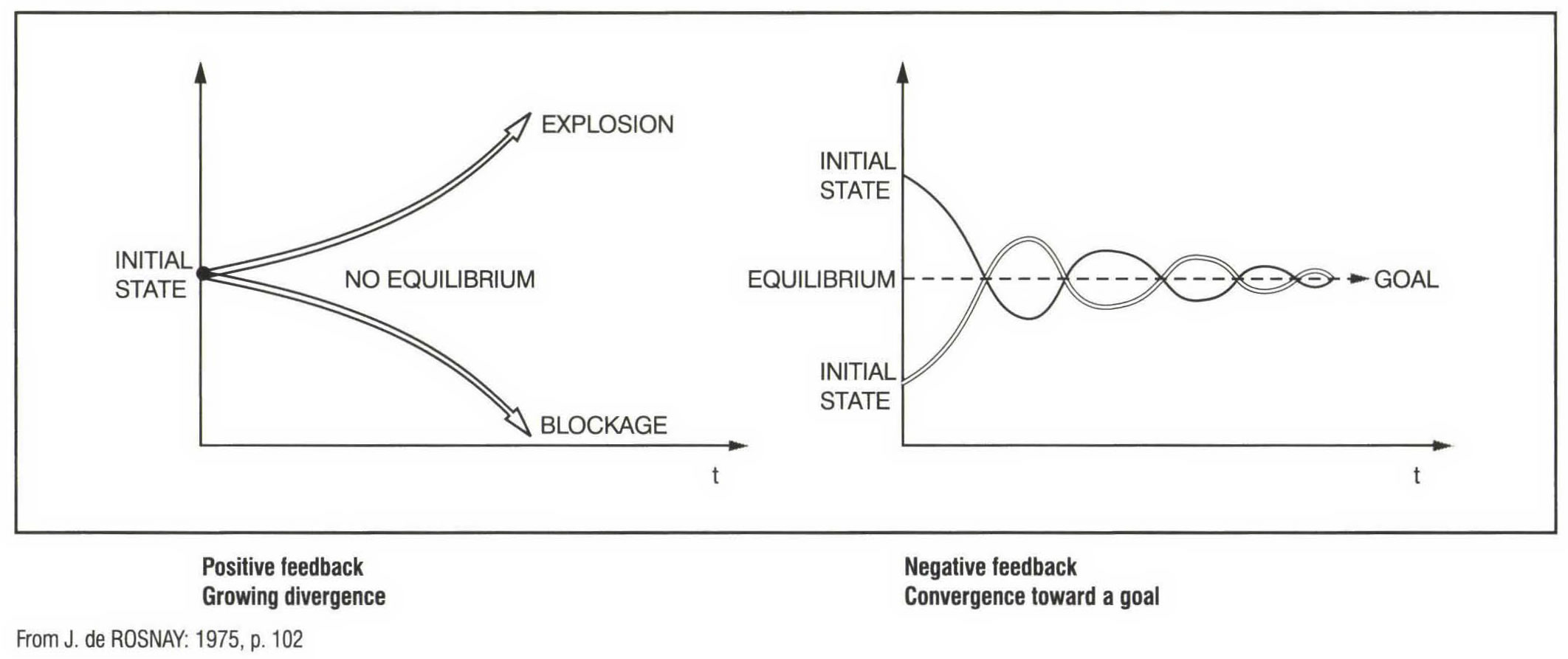FEEDBACK (Positive and Negative) 1)2)
← Back
There is some redundancy in feedback terminology.
According to J.H. MILSUM "… the following approximate equivalence exist between … various expressions (in use):
"Positive feedback or Positively- connected loop equals: Deviation-amplifying Mutual Causal Loop (MARUYAMA), Disequilibrating Feedback (BOULDING).
"Negative feedback or Negatively-connected loop equals: Deviation-counteracting (or Attenuating) Mutual Causal Loop (MARUYAMA); Equilibrating Feedback (BOULDING)" (1968, p.23).
J.de ROSNAY describes the different types of feedbacks in this way:
"In any feedback (as its name shows), informations about the results of some transformation or action are sent back at the entry of the system, as data. If these new data tend to make easier or accelerate the transformation in the same direction as the former results, we have a positive feedback: its effects are cumulative. On the contrary, if these new data acts in the direction opposite to the former results, we have a negative feedback: its effects stabilize the system. In the first case, there is an exponential growth or decrease;. in the second one, equilibrium is maintained.

J.de ROSNAY insists on the destructive effects of positive feedbacks:
"A positive feedback leads to a divergent behavior: illimited expansion, explosion (runaway to infinity) or complete block up of activities (runaway towards zero), as "more" engenders "more", with a "snowball effect". There are numerous examples: chain reaction, demographic growth, growth of a business, capital with compound interests, inflation, cancerous cells proliferation.
"On the contrary when "less" engenders "less", everything is shrinking. Some typical examples are default of a business or economic depression" (As shown by J.M. KEYNES).
"In either case a positive feedback left free can only lead to destruction of the system, be it by explosion, be it by blockage of all its functions. The exuberance of positive feedback - this potential death - must be controled by negative feedbacks.
"This is the essential condition if a system is to maintain itself through time.
"A negative feedback leads to an adaptive or finalized behavior, i.e. converging towards an objective: maintaining a level, a temperature, a concentration, a velocity, a course.
"In some cases, the goal became established by itself and has been maintained all along evolution: the system "secreted" its own finality (a steady composition of atmosphere or oceans in the ecosystem; of the level of glucose in blood, etc.). In other cases it has been set by man into machines: automata and servomechanisms.
"In a negative feedback, any positive variation evokes a negative one (and conversely). There is a regulation: the system oscillates around an equilibrium position which it may never reach: a thermostat or a water tank equipped with a float are very simple examples of regulation by negative feedback" (1975, p.102-3).
The notions of positive or negative feedbacks carry some quite widespread ambiguities:
1- Those not familiar with the question tend to associate "positive" with "good" and "favorable" and negative with the contrary. While it is not exactly the opposite way, it is correct that positive feedbacks are generally destructive when repeated, while negative feedbacks (as understood by de ROSNAY) (see below) have regulating and equilibrating effects.
2- Some understand as "negative feedback ", the "less" brings about "the less" described by de ROSNAY, as one of two opposite kinds of positive feedback. In this case, the negative feedback of de ROSNAY could be described as "compensated feedback" or "regulator": an alternance of accelerating and braking effects. There is no rigid convergence towards some goal, but the maintenance of dynamic stability (or homeostasis) within a maximal and a minimal value.

Categories
- 1) General information
- 2) Methodology or model
- 3) Epistemology, ontology and semantics
- 4) Human sciences
- 5) Discipline oriented
Publisher
Bertalanffy Center for the Study of Systems Science(2020).
To cite this page, please use the following information:
Bertalanffy Center for the Study of Systems Science (2020). Title of the entry. In Charles François (Ed.), International Encyclopedia of Systems and Cybernetics (2). Retrieved from www.systemspedia.org/[full/url]
We thank the following partners for making the open access of this volume possible:

